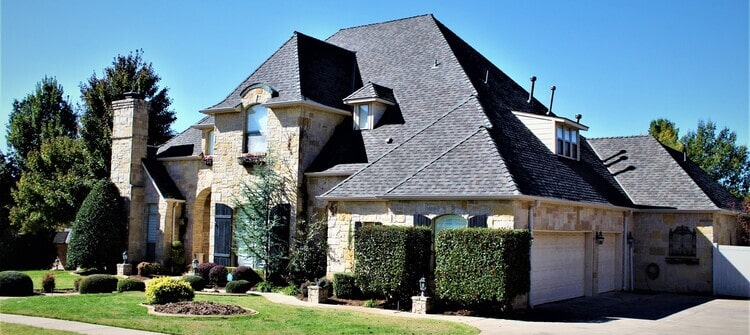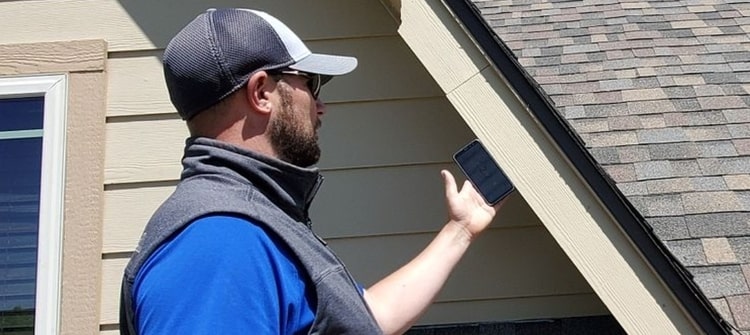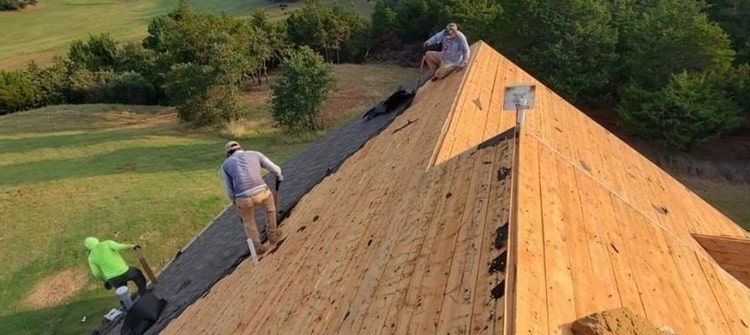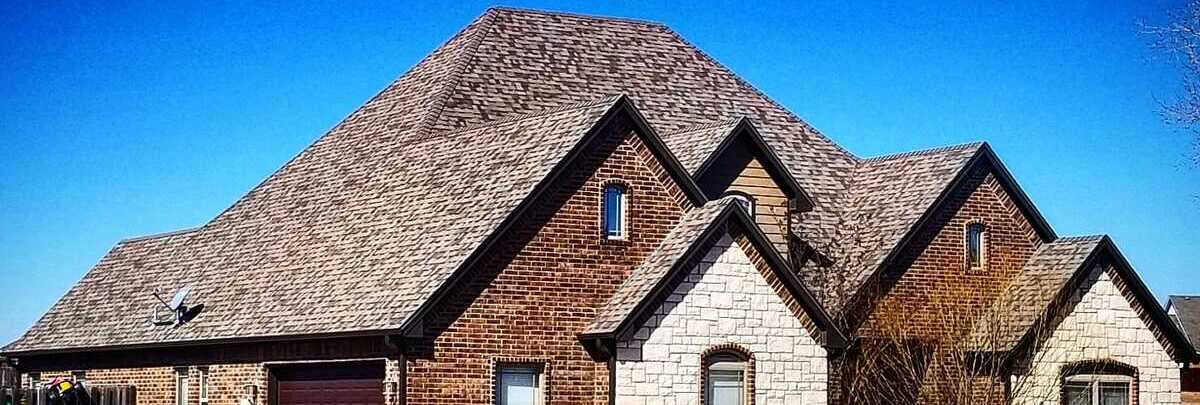Welcome to our ultimate guide, which aims to provide you with all the information you need to make an informed decision when choosing between various Oklahoma Roof Types.
The climate in Oklahoma, known for its high winds and severe weather, makes it necessary to choose the right roofing type for your home or commercial building. But with so many options out there, it can be overwhelming.
Don’t worry; we’ve got your back!
The Ultimate Guide to Oklahoma Roof Types
Oklahoma is known for its unique weather pattern, which includes intense heat, wind, and hailstorms.
Therefore, understanding the different types of roofs available, their pros and cons, and their suitability for Oklahoma’s climate can help you make the best choice.
This section aims to unravel the diversity of roof types that thrive in the Oklahoma environment.
Asphalt Shingles: The Preferred Selection
Asphalt roofs are one of the most widely utilized roofing options in Oklahoma and the United States.
Their balance of affordability, versatility, and performance makes them an attractive choice for many homeowners.

Characteristics of Asphalt Roofs
Asphalt shingles are primarily composed of a base material (organic felt or fiberglass), then coated with an asphalt layer to provide water resistance.
The outer surface is embedded with granules that block UV rays, add color, and contribute to the shingle’s overall aesthetic.
These roofs are loved for their relative durability. While they may not last as long as slate or metal roofs, a well-maintained asphalt roof can serve a home for around 20 to 30 years. They’re also fire-resistant, especially fiberglass-based shingles with a higher fire rating.
Aesthetic Flexibility of Asphalt Roofs
Asphalt shingles come in a wide range of colors and styles, including those that mimic the look of more expensive materials like wood or slate.
This aesthetic flexibility allows homeowners to customize their roofs to match their specific style preferences and the architectural design of their homes.
Installation and Maintenance of Asphalt Roofs
The installation process for asphalt shingles is less complex than other roofing materials, which can translate to lower labor costs. However, to ensure optimal performance and lifespan, a professional Oklahoma roofer should still have the installation done.
Maintenance of an asphalt roof typically involves routine inspections to identify any signs of damage or wear, prompt repairs as necessary, and occasional cleaning to remove any accumulated debris or algae.
With these simple steps, an asphalt roof can continue to protect and enhance the appeal of a home for many years.
Metal Roofs: Robust and Thermally Efficient
Metal roofs are becoming an increasingly popular choice for many Oklahoma homeowners due to their resilience, energy efficiency, and sleek modern aesthetics.


Features of Metal Roofs
Metal roofs are exceptionally durable and can withstand extreme weather conditions like heavy rain, high winds, and hail, sometimes experienced in Oklahoma.
They are also fire-resistant, contributing to the overall safety of the home.
One of the key selling points of metal roofs is their longevity. Depending on the type of metal used and the quality of installation and maintenance, a metal roof can last anywhere from 40 to 70 years, significantly longer than traditional asphalt roofing.
Energy Efficiency and Sustainability
Metal roofs are highly energy efficient. They reflect solar radiant heat, which can reduce cooling costs during hot Oklahoma summers by 10-25%. This makes them an excellent choice for homeowners looking to reduce their environmental footprint and save on energy costs.
Furthermore, metal roofs are often made from recycled materials and are entirely recyclable at the end of their life. This makes them a more environmentally friendly choice than other roofing options.
Types of Metal Roofs and Installation
Metal roofs come in various styles, including standing seam, metal tiles, metal shingles, and materials such as steel, aluminum, copper, and zinc. Each has its unique look, cost, and benefit.
Installation of a metal roof requires professional expertise. While the initial cost of a metal roof can be higher than other roofing types, its longevity, durability, and energy efficiency can make it a wise investment over time.
In terms of maintenance, metal roofs require minimal upkeep. Regular inspections, debris removal, and prompt attention to any scratches or areas of wear will help ensure a metal roof’s performance and longevity.
Slate Roofs: The Luxurious Option
Slate roofs are another roof type that has stood the test in Oklahoma. Known for their remarkable longevity and striking appearance, these roofs add elegance to any structure.
While slate roofs require a significant initial investment, their lifespan can exceed 100 years, making them a cost-effective choice in the long run.
Characteristics of Slate Roofs
Slate is a natural stone that boasts exceptional durability. It can withstand harsh weather conditions, including high winds, heavy rains, and snow, making it ideal for Oklahoma’s varied climate.
A well-maintained slate roof can last over a century, significantly outliving most other roofing materials.
Beyond durability, slate roofs are fire-resistant and eco-friendly. Since slate is a natural, sustainable material, a roof made from it doesn’t contribute to pollution at the end of its lifecycle, unlike synthetic roofing materials.
Aesthetic Appeal of Slate Roofs
The aesthetic appeal of slate is unmatched. Available in varying shades of grey, green, purple, black, and red, slate roofs can complement virtually any architectural style.
Their natural variation adds a unique, textured look that enriches the overall curb appeal of the building.
Installation and Maintenance of Slate Roofs
Installing a slate roof is a complex task that requires skilled workmanship. Therefore, hiring experienced professionals specializing in slate roofing is crucial.
Similarly, while slate roofs are low-maintenance, periodic inspections by a professional are recommended to address any potential issues early.
Despite their higher upfront cost, slate roofs’ longevity and timeless appeal make them a valuable investment for many Oklahoma homeowners and commercial property owners.
Tile Roofs: Classic Elegance and Longevity
Tile roofs are a classic roofing option in Oklahoma, highly prized for their unique aesthetic appeal and enduring performance. These roofs offer a distinctive look that can drastically enhance a property’s curb appeal.
Characteristics of Tile Roofs
Tile roofs are incredibly durable and can withstand severe weather conditions such as intense sunlight, high winds, and heavy rains that Oklahoma may occasionally experience.
Depending on the quality of installation and maintenance, tile roofs can last up to 50 years or more.
Another advantage of tile roofs is their fire resistance. Given the material’s inherent fireproof properties, tile roofs can offer additional protection for your home.
Aesthetics and Types of Tile Roofs
One of the key selling points of tile roofs is their beauty. With various shapes, colors, and finishes available, homeowners can create a unique and personalized look that complements the architectural style of their property.
Tile roofs can resemble traditional barrel tile (Spanish or Mediterranean look), flat, or even a style resembling wood shakes.
The two most common types of tile roofs are clay and concrete. Clay tiles are typically more expensive but offer a timeless, classic look and longer lifespan. Concrete tiles, conversely, are more affordable and come in a wider variety of colors and styles.
Installation and Maintenance of Tile Roofs
Installation of a tile roof is a complex process that requires professional expertise and experience. It’s crucial to ensure that the roof structure can support the weight of the tiles, as they are heavier than other roofing materials.
Maintenance of a tile roof generally involves periodic inspections, cleaning to remove dirt and debris, and replacing cracked or broken tiles. With proper care, a tile roof can continue to add character and value to your home for many years.
Wood Shakes and Shingles: The Charm of Rusticity
Wood shakes and shingles offer a distinctive, natural aesthetic that many Oklahoma homeowners find appealing. These roofs can provide a charm and character that is hard to match with other roofing materials.


Features of Wood Shakes and Shingles
They are known for their durability and resistance to severe storms and wind, an essential consideration in Oklahoma’s varied climate. They are typically made from cedar, redwood, or southern pine, all with inherent resistance to rot and insects.
While wood shingles require regular maintenance to prevent insect decay and damage, they provide excellent insulation and can last up to 30 years.
It’s worth noting that wood shakes have a higher insulative value than many other roofing materials. This can help keep your home cooler in the summer and warmer in the winter, potentially reducing energy costs.
Aesthetics of Wood
The aesthetic appeal of wood is undeniable. They offer a rustic yet refined look that can enhance the architectural style of various homes, from traditional to contemporary. Over time, these roofs become silvery gray, further adding to their charm.
Installation and Maintenance of Wood Roofs
A professional roofer with experience in this type of roofing material should carry out the installation of wood shingles. The installation process is more complex than for asphalt shingles, as each wooden shake or shingle needs to be individually nailed to the roof deck.
Maintenance for a wood roof involves regular cleaning to prevent the buildup of moss or algae, which can degrade the wood over time.
It’s also crucial to promptly replace any split or cracked shakes or shingles to prevent water damage to the roof structure.
Despite requiring a bit more maintenance than some other roof types, wood shakes, and shingles can offer a unique, natural beauty and a durable roofing solution for homeowners in Oklahoma.
Flat Roofs: Sleek and Space-Saving
Flat roofs have become popular for many residential and commercial buildings in Oklahoma, known for their modern aesthetics and functional benefits.
Features of Flat Roofs
As the name suggests, flat roofs have a shallow slope and appear nearly level. One of the critical advantages of flat roofs is the extra usable space they provide. This space can be used for various purposes, such as installing HVAC units, creating a rooftop garden, or setting up a leisure area.
Flat roofs are also more accessible and safer to inspect and maintain due to their lack of slope. This can make routine tasks like gutter cleaning and roofing inspections less risky.
Types of Flat Roofs
There are several flat roofing systems, each with advantages and considerations. These include built-up roofs (BUR), modified bitumen roofs, and rubber membrane or EPDM roofs.
Built-up roofs are made of several layers of roofing felt impregnated with asphalt, with a top layer of gravel or similar material. They are known for their durability and excellent waterproofing properties.
Modified bitumen roofs are a more modern alternative to built-up roofs, offering similar durability but added flexibility and resistance to temperature fluctuations.
Rubber membrane or EPDM (ethylene propylene diene monomer) roofs are made from a durable rubber material. They’re highly resistant to weathering and easy to repair but can be more expensive than other options.
Installation and Maintenance of Flat Roofs
A professional should install a flat roof to ensure proper sealing and avoid water pooling. The exact installation process will depend on the flat roofing system chosen.
Maintenance of a flat roof involves regular inspections to check for and fix any signs of damage or wear, such as cracking or blistering. Drains should be kept clear of debris to ensure proper water runoff.
A flat roof can last 20 to 30 years with proper installation and routine maintenance, depending on the material used.
Green Roofs: Natural Coverage
Green roofs are an innovative and environmentally friendly roofing option growing in popularity as a popular Oklahoma roof type. Offering a blend of aesthetic appeal, energy efficiency, and sustainability, green roofs represent a unique take on traditional roofing systems.
Characteristics of Green Roofs
A green roof, a living roof, is essentially a rooftop garden. It involves the installation of a waterproof membrane on the roof, which is then covered with a growing medium and planted with vegetation.
Green roofs offer significant environmental benefits. They can help to reduce stormwater runoff by absorbing rainwater, which is then returned to the atmosphere through evapotranspiration. They also help to mitigate the urban heat island effect by lowering the temperature of the roof surface.
A well-maintained green roof can last 30 to 50 years or even longer. The exact lifespan depends on various factors, including the quality of installation, the type of plants used, the climate, and regular maintenance.
Energy Efficiency and Sustainability
Green roofs are highly energy efficient. The layer of soil and plants provides excellent insulation, helping to reduce the energy needed for heating and cooling the building. This can result in substantial energy savings over the life of the roof.
Additionally, green roofs contribute to biodiversity by providing a habitat for birds and insects. They also help to improve air quality by filtering pollutants and carbon dioxide out of the air.
Types of Green Roofs and Installation
Green roofs can be categorized into two main types: extensive and intensive. Extensive green roofs have a thin layer of soil and are planted with low-maintenance plants like sedums and mosses. They are lighter and require less maintenance but offer less biodiversity.
On the other hand, intensive green roofs have a thicker layer of soil that can support a wider variety of plants, including shrubs and small trees. However, they are heavier and require more maintenance.
Installing a green roof is a complex process that requires professional expertise. The roof structure must support the additional weight of the soil and vegetation. Also, the waterproof membrane must be installed correctly to prevent leaks.
Overall, while the initial cost and maintenance requirements can be higher for green roofs than traditional roofing materials, their environmental benefits and aesthetic appeal can make them a worthwhile investment for many homeowners.


Comparing Oklahoma Roof Types
Now that we’ve gone through Oklahoma’s most common roof types let’s see how they compare in terms of cost, durability, and energy efficiency.
Cost Comparison
Cost is a significant factor when choosing a roof type. The price can vary significantly between different materials, with slate and metal roofs typically costing more than asphalt or wood shingles.
Durability Comparison
The lifespan of a roof is another crucial consideration. While slate roofs can last over a century, asphalt shingles usually need to be replaced after 20 to 30 years. Meanwhile, metal roofs can last up to 70 years with proper maintenance.
Energy Efficiency Comparison
Energy efficiency is becoming increasingly important for homeowners. Roofs like metal, slate, and green roofs offer excellent insulation, significantly reducing cooling and heating costs.
Considerations for Choosing Your Roof
When selecting your roof type, consider factors such as the roof’s lifespan, maintenance requirements, and cost-effectiveness. Energy efficiency, sustainability, and aesthetic appeal are important considerations influencing your choice.
Moreover, working with a reputable, experienced roofing contractor ensures a high-quality installation and provides peace of mind knowing your roof is well-suited to Oklahoma’s unique climate conditions.
Remember, your roof is a significant investment that can dramatically impact your home’s curb appeal, energy efficiency, and overall value. Therefore, selecting the right roof type for your Oklahoma home is crucial.
The Importance of Regular Roof Maintenance
Maintaining your roof in Oklahoma can be quite a task, given the state’s distinct climate featuring high winds, hailstorms, and intense heat. However, regular maintenance is paramount in ensuring your roof’s longevity, regardless of its type. It is essential to have a professional roofer inspect your roof after a hailstorm.
Regular Inspections
Initiate the maintenance process with regular roof inspections. Engage a professional roofing contractor to conduct an assessment at least twice a year, usually in spring and fall.
The professional eye can spot potential issues that might escalate if left unattended. This can include broken or missing shingles, rust spots on metal roofs, or cracks in tiles.
Clean Your Roof
Debris, such as leaves and branches, can accumulate on your roof, leading to moisture build-up and, eventually, rot. Clear off the debris regularly to prevent water pooling. If you have a green roof, keep the vegetation trimmed and healthy to prevent overgrowth.
Gutter Maintenance
The state of your gutters significantly impacts your roof’s health. Clogged gutters can lead to water overflow, seeping into the roof, causing structural damage. Regularly cleaning your gutters can prevent such problems.
Sealant Replacement
Over time, the sealant used around roof fixtures can crack or peel, leading to water leaks. Inspect the sealant around vent pipes, chimneys, and skylights regularly. Replace the sealant as required to keep your roof leak-free.
Check for Moss and Algae
Roofs often become breeding grounds for moss and algae in Oklahoma’s humid climate. If not addressed, this can lead to the roof material’s degradation. Use a moss remover or hire a professional service to deal with the issue.
Maintaining your roof is not a ‘one size fits all’ process; it’s unique to the roof type and the specific challenges your local climate poses.
By following these maintenance practices, you can extend the life of your roof and protect your home in the unpredictable Oklahoma weather.


Oklahoma’s Roofing Regulations and Permits
Navigating through the world of roofing regulations and permits can be quite a challenge. However, before you embark on any roofing project in Oklahoma, it’s critical to understand and comply with these guidelines. This ensures that your project runs smoothly and adheres to the safety and quality standards set by the state.
Roofing Contractor License
First and foremost, it’s crucial to ensure that the contractor you hire has a valid roofing license. The Construction Industries Board (CIB) regulates roofing contractor licensing in Oklahoma. Working with a licensed contractor ensures that the individual or company is knowledgeable about local codes and regulations and is accountable for the quality of their work.
Permit Requirements
Before starting a roofing project, homeowners are often required to obtain a roofing permit, especially for large-scale projects such as a complete roof replacement or major repairs. The requirements vary by city or county, so checking with your local building department is essential. This permit allows local authorities to ensure the work aligns with local codes and safety regulations.
Building Codes and Standards
Oklahoma follows the International Residential Code (IRC), which sets standards for roof structures and materials to ensure safety and durability. This includes guidelines on materials, proper installation methods, wind resistance, and more.
Insurance Regulations
Another critical aspect of roofing in Oklahoma is understanding the state’s insurance regulations. Homeowner’s insurance often covers roof damage, but the terms vary widely. You must check with your insurance provider about what’s covered and any related regulations.
Navigating through these regulations and permits can feel overwhelming.
However, most professional roofing contractors in Oklahoma can guide you through the process, ensuring that your roofing project complies with all local and state requirements, ultimately safeguarding your investment.
Final Thoughts
Choosing the right roof for your Oklahoma home is a significant decision that can impact your home’s value, energy efficiency, and resilience against Oklahoma’s harsh weather.
This guide aims to equip you with the knowledge needed to make an informed choice that suits your preferences and needs.
We hope you found our Ultimate Guide to Oklahoma Roof Types valuable and insightful.
Should you have any more queries or need further assistance, don’t hesitate to contact a local roofing professional.


Frequently Asked Questions
What is the most common type of roofing in Oklahoma?
Asphalt shingles are the most common type of roofing in Oklahoma. They offer a good balance of affordability, durability, and weather resistance.
Which type of roof is best for Oklahoma’s weather?
Metal roofs and asphalt shingles are considered the best options for Oklahoma’s weather. Both materials can withstand high winds, hail, and extreme heat, which are common in the state.
How long can a roof last in Oklahoma?
A roof’s lifespan in Oklahoma can vary widely depending on the material. Asphalt shingles typically last 20-30 years, metal roofs last up to 70 years, and slate roofs last over 100 years with proper maintenance.
Are green roofs suitable for Oklahoma?
Yes, green roofs are suitable for Oklahoma. They offer excellent insulation properties and can help reduce the urban heat island effect. However, they require regular maintenance and may have higher initial installation costs.
What are the local regulations for roofing in Oklahoma?
Local regulations for roofing in Oklahoma may vary depending on the city or county. Before starting any roofing project, it’s essential to check with your local municipality or a professional roofing contractor.
What is the cost of roofing in Oklahoma?
The roofing cost in Oklahoma can vary depending on the material and the roof size. Installing an asphalt shingle roof can cost between $3500 to $8000, while a metal roof can cost between $10,000 to $25,000+. For more accurate pricing, contacting a local professional roofing contractor is best.
Consider Belter Roofing
If you need professional advice or have questions regarding any Oklahoma roofing services, don’t hesitate to get in touch.
Our skilled team is dedicated to providing robust solutions and tailored support.
Contact Belter Roofing and Construction today for dependable roofing assistance.


